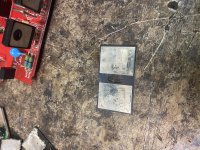Is there a place where I can buy these ?
Or anyway of making new ones ?
If not is there an alternative to these ?
A couple of them are delaminated
Would these work as replacements ?
https://www.mouser.com/ProductDetail/Aavid/4180G?qs=2v7q0MSBcBMwt5GBytMENg==
Or anyway of making new ones ?
If not is there an alternative to these ?
A couple of them are delaminated
Would these work as replacements ?
https://www.mouser.com/ProductDetail/Aavid/4180G?qs=2v7q0MSBcBMwt5GBytMENg==
Attachments
Last edited:
I don't know on that amp. The ceramic insulators are good but the original insulators are very good and act as a heat spreader.
If you use the thicker ceramic insulators, be sure that the leads are formed to allow the transistors to lay perfectly flat with no pressure applied.
Is the delamination under the transistor body?
If you use the thicker ceramic insulators, be sure that the leads are formed to allow the transistors to lay perfectly flat with no pressure applied.
Is the delamination under the transistor body?
Do you happen to know what the original insulators are made out of?
Wondering if I can go get some material and use mica insulators under the transistors ?
A couple are delaminated and it’s also missing a few of them to put this amp back together
Wondering if I can go get some material and use mica insulators under the transistors ?
A couple are delaminated and it’s also missing a few of them to put this amp back together
You can find more information (and possibly replacements) by searching for:
insulated metal substrate
It's basically copper bonded to ceramic bonded to aluminum.
You may be able to use copper stock with an insulator between the copper stock and the heatsink. For any piece of copper stock, ONLY FETs that are connected in parallel can be on that piece of stock. You could insulate between the transistor and the copper but that would defeat the the purpose of the heat spreader.
If you use any piece of stock, it must be perfectly flat have have ALL burrs removed.
insulated metal substrate
It's basically copper bonded to ceramic bonded to aluminum.
You may be able to use copper stock with an insulator between the copper stock and the heatsink. For any piece of copper stock, ONLY FETs that are connected in parallel can be on that piece of stock. You could insulate between the transistor and the copper but that would defeat the the purpose of the heat spreader.
If you use any piece of stock, it must be perfectly flat have have ALL burrs removed.
I had a similar situation and it was not delamination. When the output devices failed it created enough heat to melt the solder that was used to tin the insulator. I ended up using leaded solder (40/60) to re-flow the surface. I then carefully wicked away as much as possible, leaving a perfectly flat and serviceable surface. Naturally after fitting it into the amp I confirmed that there were no shorts between the devices sharing an insulator or the heat sink.
My example was also from an Orion.
My example was also from an Orion.
- Home
- General Interest
- Car Audio
- Insulator Question
